The Experts at London’s Smith & Partner Share Four Fascinating Stories Behind a Set of Picasso Portraits
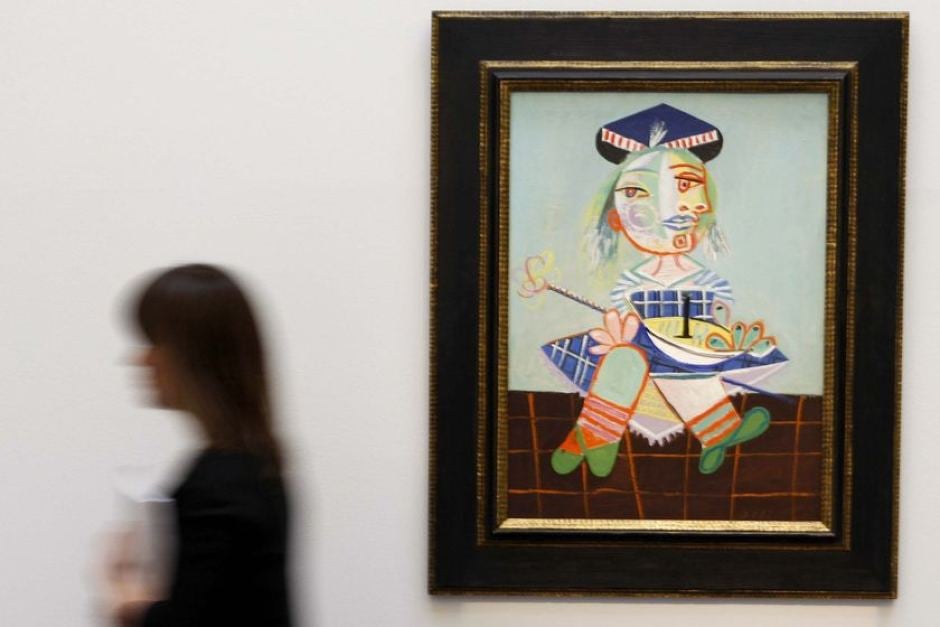

Artnet Gallery Network

Picasso paintings often earn headlines for selling for huge sums at auction, but lovers of the famous Spanish artist might be surprised to find that many of his prints can be obtained at a much more accessible price.
London’s Smith & Partner, a leading prints specialist, is currently offering a strikingly colorful set of lithographs by the artist with a premier provenance: the four works, all portraits of important women in his life, come from the collection of Marina Picasso, the artist’s granddaughter.
Picasso left no will, and after a lengthy legal process following his death, one-fifth of his estate was passed on to Marina Picasso, who was the daughter of Paolo, Picasso’s son with Ukrainian ballet dancer Olga Khokhlova.
Raised away from the wealth and fame of Picasso, Marina Picasso became a philanthropist and has used her inheritance to fund numerous charity causes, including establishing an orphanage in Vietnam called the Village of Youth.
These works were printed between 1979 and 1982, several years after the artist’s death, as a posthumous edition, under the supervision of one of Picasso’s closest creative partners, the master Chromist Laurent Marcel Salinas, and include portrayals of fellow artist and muse Dora Maar (Buste De Femme) as well as his beloved daughter, Maya (La Fille de L`artiste a Deux Ans Et Demi Avec Un Bateau).
Below, the experts at Smith & Partner share fascinating insights into these four portraits.
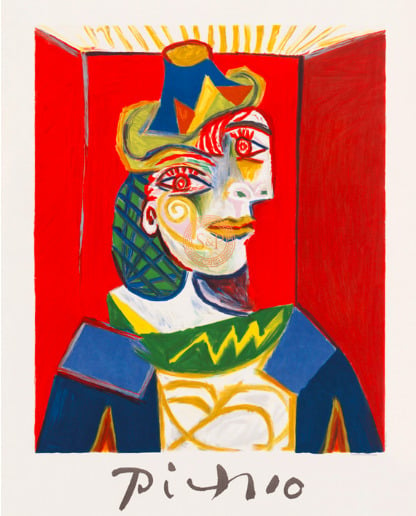
Pablo Picasso, Buste de femme.Courtesy of Smith & Partners.
“This picture is one of the best-known of Picasso’s series of images of Dora Maar. The electric red lends an intensity that heightens the colors of Picasso’s muse’s face and clothing. The yellows, blues, and greens thrust themselves into a bold relief through their contrast with the near-monochrome background. It is a joyful rendition that was created at the height of the artists’ relationship. Anecdotally, Buste De Femme (Femme à la résille) was one of the paintings with which Picasso was unable to part during his lifetime, only changing hands after his death, whereby it was inherited by his granddaughter, Marina.”
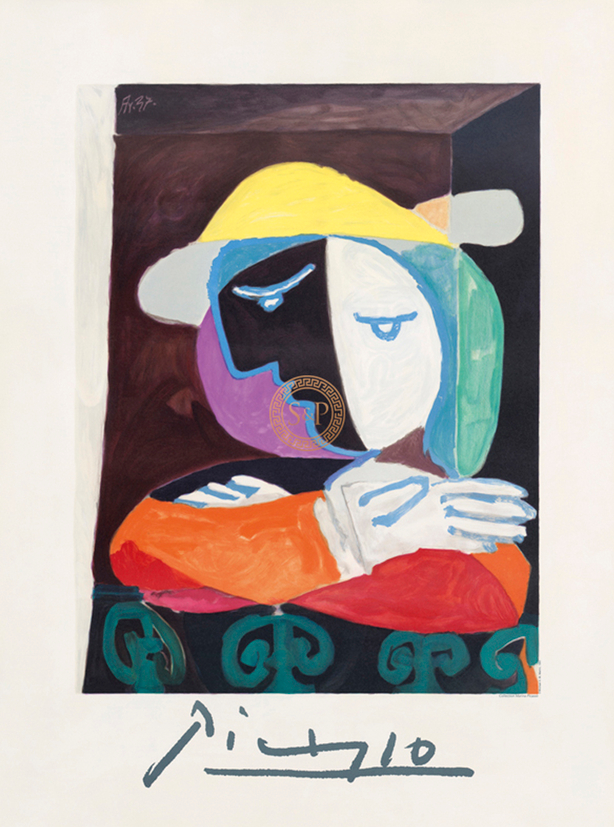
Pablo Picasso, La Fille de L`artiste a Deux Ans Et Demi Avec Un Bateau. Courtesy of Smith & Partners.
“During the early 20th century, Picasso was working alongside George Braque with inspiration from African sculptures to create a new movement that came to be known as Cubism. Here, in Femme Au Balcon, we see Picasso’s Cubist elements blend with portraiture to create this image full of color and life.
Leaning against the curved railing of the balcony, the model in this print is depicted through a series of shapes and forms of varying colors layered over one another. A typical example of Picasso’s work, this print demonstrates the artist’s ability to manipulate perspective and create unique views of his subjects.”
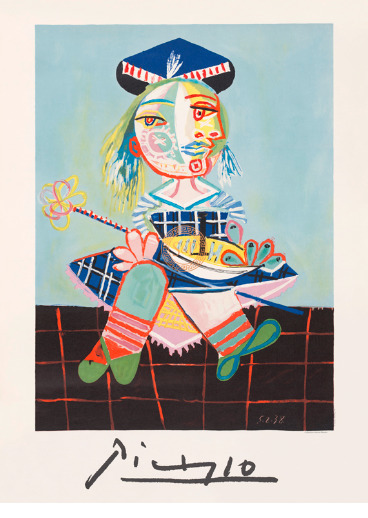
Pablo Picasso, La Fille de L`artiste a Deux Ans Et Demi Avec Un Bateau. Courtesy of Smith & Partners.
“A spirited Maya Picasso, aged two-and-a-half, is the subject of this vivid portrait from 1938. Painted only months after Picasso finished his harrowing Guernica, this picture clearly evidences that Maya, daughter of Marie-Thérèse Walter, was a great source of joy in Picasso’s life. The baby girl presented new and delightful artistic challenges for her father. Picasso’s palette for this picture captures the liveliness and playfulness of Maya’s nursery. For the background, he chose a robin’s egg blue, which he also uses for the highlights of her blonde hair. He depicts her holding a favorite toy boat, which features in other portraits from this time, and a colorful pinwheel in her chubby hand. This colorful, boisterous print by Pablo Picasso showcases his talent as a proponent of Cubism. Now 86 years old, Maya lives in Paris, has three children, and is also one of Picasso’s five surviving heirs, alongside Marina.”
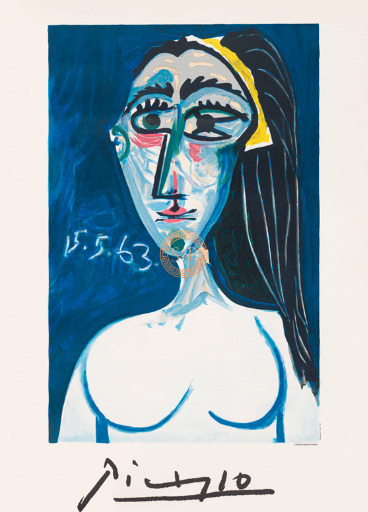
Pablo Picasso, Buste De Femme Nue Face. Courtesy of Smith & Partners.
“Picasso’s nude portrait of his wife and muse Jacqueline Roque is one of the hundreds of portraits that he painted of her in the 11 years of their marriage. He met her when she was just 26, himself 72, and convinced her to date him by drawing a chalk dove on her house and bringing her a rose every day for six months.
“Picasso painted her as angular and elongated, with her face characterized by large eyes and high-set cheekbones. The shades of deep blue lay fluidly on the canvas with bright whites and a vibrant yellow are reminiscent of the artist’s early Blue Period, yet now combined with the energy he had for life and all its wonder. After Pablo’s death in 1973, Jacqueline prevented Picasso’s children, Claude and Paloma Picasso from attending his funeral. Jacqueline also barred Picasso’s grandson, Pablito Picasso, Marina Picasso’s younger brother, from attending the service. Pablito was so distraught, he drank a bottle of bleach, from which he died three months later. The death of her brother is a key reason Marina chose to sell all of the work she had inherited, for it could not be helped but associated with his passing.”